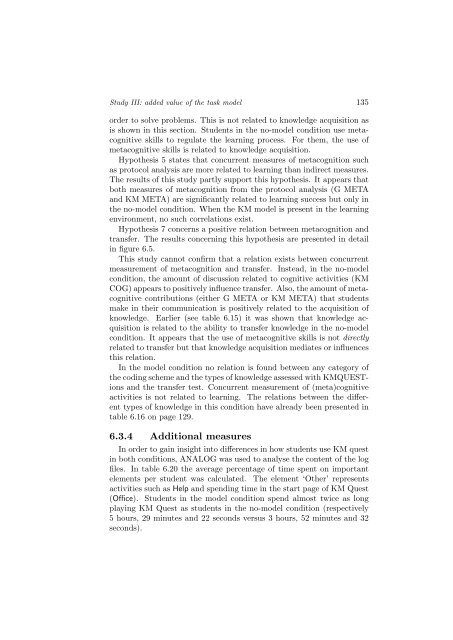The role of metacognitive skills in learning to solve problems
The role of metacognitive skills in learning to solve problems
The role of metacognitive skills in learning to solve problems
You also want an ePaper? Increase the reach of your titles
YUMPU automatically turns print PDFs into web optimized ePapers that Google loves.
Study III: added value <strong>of</strong> the task model 135<br />
order <strong>to</strong> <strong>solve</strong> <strong>problems</strong>. This is not related <strong>to</strong> knowledge acquisition as<br />
is shown <strong>in</strong> this section. Students <strong>in</strong> the no-model condition use <strong>metacognitive</strong><br />
<strong>skills</strong> <strong>to</strong> regulate the learn<strong>in</strong>g process. For them, the use <strong>of</strong><br />
<strong>metacognitive</strong> <strong>skills</strong> is related <strong>to</strong> knowledge acquisition.<br />
Hypothesis 5 states that concurrent measures <strong>of</strong> metacognition such<br />
as pro<strong>to</strong>col analysis are more related <strong>to</strong> learn<strong>in</strong>g than <strong>in</strong>direct measures.<br />
<strong>The</strong> results <strong>of</strong> this study partly support this hypothesis. It appears that<br />
both measures <strong>of</strong> metacognition from the pro<strong>to</strong>col analysis (G META<br />
and KM META) are significantly related <strong>to</strong> learn<strong>in</strong>g success but only <strong>in</strong><br />
the no-model condition. When the KM model is present <strong>in</strong> the learn<strong>in</strong>g<br />
environment, no such correlations exist.<br />
Hypothesis 7 concerns a positive relation between metacognition and<br />
transfer. <strong>The</strong> results concern<strong>in</strong>g this hypothesis are presented <strong>in</strong> detail<br />
<strong>in</strong> figure 6.5.<br />
This study cannot confirm that a relation exists between concurrent<br />
measurement <strong>of</strong> metacognition and transfer. Instead, <strong>in</strong> the no-model<br />
condition, the amount <strong>of</strong> discussion related <strong>to</strong> cognitive activities (KM<br />
COG) appears <strong>to</strong> positively <strong>in</strong>fluence transfer. Also, the amount <strong>of</strong> <strong>metacognitive</strong><br />
contributions (either G META or KM META) that students<br />
make <strong>in</strong> their communication is positively related <strong>to</strong> the acquisition <strong>of</strong><br />
knowledge. Earlier (see table 6.15) it was shown that knowledge acquisition<br />
is related <strong>to</strong> the ability <strong>to</strong> transfer knowledge <strong>in</strong> the no-model<br />
condition. It appears that the use <strong>of</strong> <strong>metacognitive</strong> <strong>skills</strong> is not directly<br />
related <strong>to</strong> transfer but that knowledge acquisition mediates or <strong>in</strong>fluences<br />
this relation.<br />
In the model condition no relation is found between any category <strong>of</strong><br />
the cod<strong>in</strong>g scheme and the types <strong>of</strong> knowledge assessed with KMQUESTions<br />
and the transfer test. Concurrent measurement <strong>of</strong> (meta)cognitive<br />
activities is not related <strong>to</strong> learn<strong>in</strong>g. <strong>The</strong> relations between the different<br />
types <strong>of</strong> knowledge <strong>in</strong> this condition have already been presented <strong>in</strong><br />
table 6.16 on page 129.<br />
6.3.4 Additional measures<br />
In order <strong>to</strong> ga<strong>in</strong> <strong>in</strong>sight <strong>in</strong><strong>to</strong> differences <strong>in</strong> how students use KM quest<br />
<strong>in</strong> both conditions, ANALOG was used <strong>to</strong> analyse the content <strong>of</strong> the log<br />
files. In table 6.20 the average percentage <strong>of</strong> time spent on important<br />
elements per student was calculated. <strong>The</strong> element ‘Other’ represents<br />
activities such as Help and spend<strong>in</strong>g time <strong>in</strong> the start page <strong>of</strong> KM Quest<br />
(Office). Students <strong>in</strong> the model condition spend almost twice as long<br />
play<strong>in</strong>g KM Quest as students <strong>in</strong> the no-model condition (respectively<br />
5 hours, 29 m<strong>in</strong>utes and 22 seconds versus 3 hours, 52 m<strong>in</strong>utes and 32<br />
seconds).
















